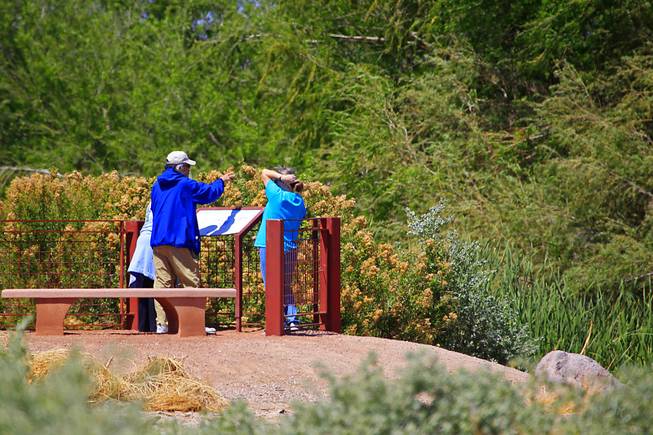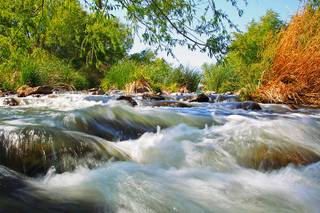Friday, April 20, 2012 | 6 p.m.
We’re hoping to see the black-tailed gnatcatcher, because it’s quite the stunning little bird, round and insectivorous, with a fantastic name. The Clark County Wetlands Park visitors center gives us a better idea of what we’ll actually see while wandering the preserve—herons, rabbits, quail—but nothing prepares us for the noontime show at West Middle Pond.
As if on cue, carp, turtles, ducks and one fat koi mingle in such a choreographed manner that I’m wondering if we should applaud from the boardwalk, or at least look for the tip jar. It’s that part in the Disney movie when everyone sings about life in nature.
There are 210 acres in this preserve inside the 2,900-acre Wetlands Park, with ponds (engineered to use reclaimed water) and the Las Vegas Wash running through on its way to Lake Mead.
This afternoon, we roam pathways under the sun, through thickets of trees, past cattail-lined ponds and along small foot-roads flanked by Common Reed, a native grass that looks like bamboo and stands 10-to-12 feet.
The Details
- Wetlands Park Nature Preserve
- dawn to dusk daily
- 7050 E. Wetlands Park Lane, 455-7522
I’m thinking of the countryside and the Dylan Thomas poem with the line, “I was famous among the barns,” or Anne Brontë’s “A light wind swept over the corn, and all nature laughed in the sunshine.”
Hallelujah, tickle me dorky. And it gets worse. We watch orange peels, and sticks get caught in creek eddies that offer their captives no hope of a journey downstream. We stare at rabbits eating from low tree branches.
The residents pay no attention to our gawking—the herons, the fish, the quail and said rabbits. The beavers are elusive, probably hiding out in their creek dens. The only beaver references we see are small wire fences erected around young trees to keep beavers from gnawing the trunks. Those and the giant beaver sculpture made by Las Vegas artist Miguel Rodriguez at the park’s entrance.
Deep in the preserve, park visitors bounce from one scenic overlook to the next. Some wind up at the bridge, cutting across the Las Vegas Wash, watching the urban runoff and storm water below start its journey through the preserve. The Wetlands are designed to reduce environmental impact. Ponds and dams help control the pace of the Wetlands water. Even cattails slow the flow, giving water time to drop its sediments. Other vegetation cleans the stream. It takes roughly a week for the water to flow through the system of ponds, created from the piping in of reclaimed water.
Plans for the Wetlands were initiated in the early ’90s, after decades of erosion killed wash vegetation and development was eliminating natural habitats. Original plans were funded by a voter-approved bond, and the first phase of construction on the preserve was completed around 2001. Funding has come mostly from bonds and sales of public land. In the 1980s the wetlands dwindled from thousands of acres to 200. The Desert Wetlands Conservancy, a private nonprofit advocacy group, originated in 1995 as the Friends of the Desert Wetlands Park to help protect and restore the wetlands but changed its name in recent years to broaden its mission to include the valley's watershed. Its focus is outreach, partnerships and influencing public policy. The Wetlands Nature Center, a 30,000-square-foot building with exhibits and classrooms is scheduled to open its administrative offices and two classrooms this summer.
The Wetlands is so dense and separate from the Valley’s neighborhoods, even in the preserve, that we forget where we are until we spot the Stratosphere in the distance or catch a glimpse of Sam Boyd Stadium. A plaque onsite dedicated to Vern Bostick, a biologist and outdoorsman who was one of the first to push for a wetlands park, includes a quote by naturalist John Muir that carries a lot of truth while lost in this place: “When one tugs at a single thing in nature, he finds it attached to the rest of the world.”
After four hours, we never find the black-tailed gnatcatcher, but I had forgotten about it anyway. There was so much else to see.



Join the Discussion:
Check this out for a full explanation of our conversion to the LiveFyre commenting system and instructions on how to sign up for an account.
Full comments policy